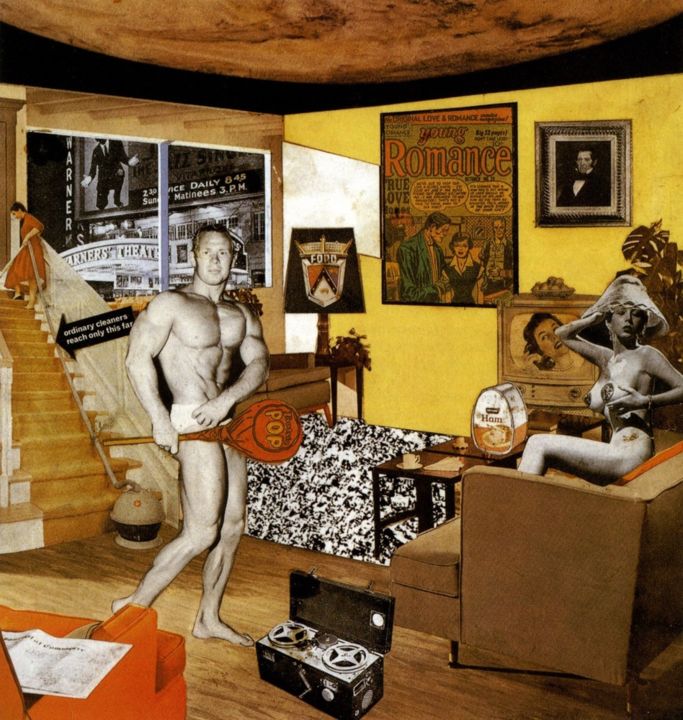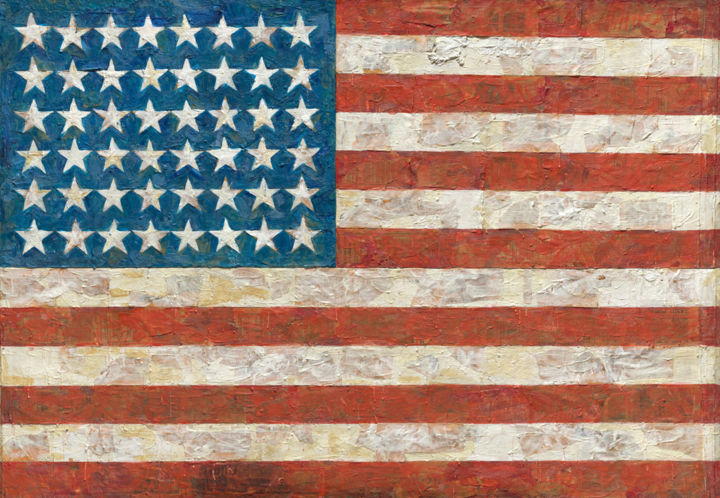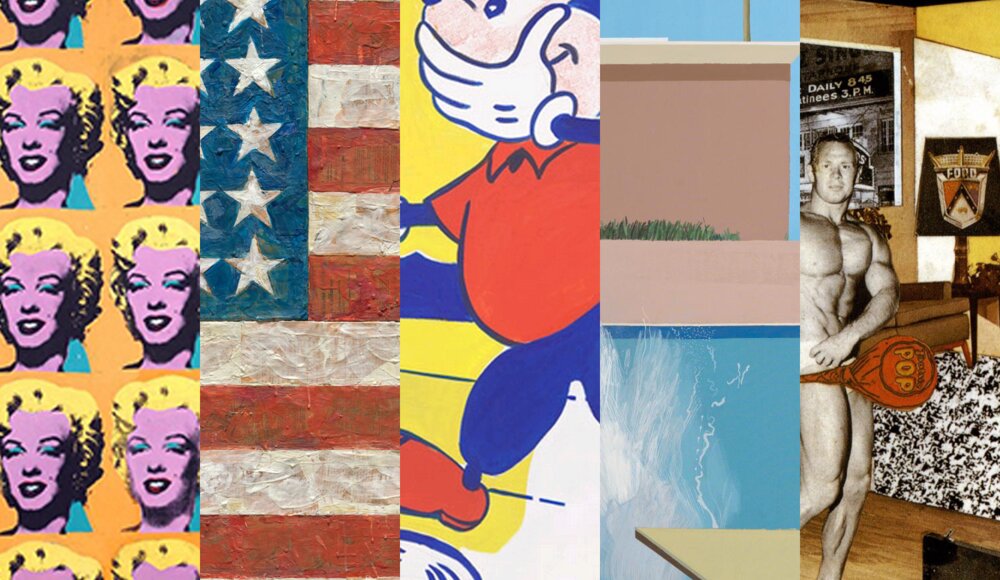
How to describe Pop Art? This international movement, which appeared in England in the mid-1950s, still has strong influence on our modern society. Sometimes considered as a direct descendant of Dadaism, this movement makes fun of the muffled world of art, by appropriating codes of Pop Culture, mass consumption, advertising, Hollywood industry, and mainstream media. Pop Art offers the viewer a new, accessible, funny and sometimes critical perspective on the failings of our consumer society. With colorful and understandable artwork, it blurs the boundaries and hierarchies between superior and inferior arts, between Fine Arts and popular art.
5. Just what is it that makes today's homes so different, so appealing?, Richard Hamilton

This artwork is rightly considered as the first true Pop Art work. Made in 1956 by the English artist Richard Hamilton, this small collage (only 26x25cm), is composed of images from American magazines. Moreover, the title of this artwork was inspired by a slogan found in one of these magazines, promoting colorful and designer flooring.
The staircase on the left side is from a vacuum cleaner ad, the bodybuilder in the middle is the winner of the 1955 Mr. L.A. contest, the woman on the couch at right is from an erotic magazine... the artwork abounds with symbols of consumer society and popular culture, which together form a bold critical pamphlet against the shortcomings of a stereotypical and self-centered society.
Richard Hamilton, aware of having opened the breach of a potential new artistic movement, started the following year to theorize the Pop Art: for him, it must be "a popular art destined to the masses, ephemeral, short term, consumable, easily forgettable, produced in series, inexpensive, young, spiritual and sexy". Some of these characteristics disappeared obviously with the passing of time (in particular concerning the price of these artworks, which reach now stratospheric sums), but others remain, still today, perfectly adequate.
4. Look Mickey, Roy Lichtenstein

After the UK, let's now change continent to look at the beginnings of American Pop Art. Roy Lichtenstein, the mischievous artist who created this artwork in 1961, was not really predestined to become the icon of Pop Art that we now know. Before this work, he was expressing his artistic ardor through abstract expressionism, an artistic movement largely dominated by his contemporaries Jackson Pollock and Willem de Kooning.
In 1961, one of his sons provoked him by showing him one of his comics and saying "I bet you can't paint as well as that! ". Roy Lichtenstein accepted the challenge and set about creating a monumental artwork (122x175cm) inspired by a comic book case (Donald Duck Lost and Found). This artwork, besides being funny and aesthetically pleasing to look at, is the avant-garde of a lot of things: it's the first real artwork that is openly inspired by the comic book universe, and it's the first artwork where the artist uses the Benday dots technique (dots arranged symmetrically and in great number, which give the illusion of a united color with distance). Today, we see Mickey everywhere in contemporary art: well, this is the artwork that represents the first intrusion of the popular mouse in the art world.
3. Flag, Jasper Johns

This impressive artwork (107x153cm) was made by Jasper Johns in 1954. It represents the American flag, with its 48 stars corresponding to the different Confederate states at that time, which does not yet include Hawaii and Alaska. When he made this artwork, Jasper Johns was only 24 years old and had just been released from his military obligations in the U.S. Army. The American flag was therefore very important in his life, but it was also very much in the News at the time.
The artwork is above all revolutionary in the subtleties of its realization. Using various techniques such as encaustic, collage from old newspapers and oil paint, the artwork is placed on the border between abstract art, still very influential in the United States, and figurative art, since the motif represented is eminently understandable. By adopting this familiar motif, he can concentrate on the plastic execution of his canvas, rather than on the symbolism of the whole. In this way, he blurs the traditional divisions in the reading of artwork: critics can no longer tell whether it' s a painted flag or a painting of a flag. For Johns, it' s both. He is thus at the heart of neo-dadaism, but also at the foundations of Pop Art, minimal art and conceptual art.
2. Marilyn Diptych, Andy Warhol

This monumental silkscreen (205x290cm) by the legendary Andy Warhol was made in 1962, just after the death of Marilyn Monroe. It consists of 50 photographs of the actress, captured in 1953 during the promotion of the film Niagara. On the left half, images are hyper colored, but on the right half, all photographs are in black and white. This choice represents the relationship of Marilyn Monroe between life and death, and it also symbolizes the two favorite themes of the American artist: death and cult of celebrity. The abundance of images reminds us of the icon's omnipresence in the media, but the right side of the panel, black and white, reminds us that this star remains mortal, while making it eternal forever through an artwork now considered by the British newspaper The Guardian as one of the 3 most influential modern artworks in the world.
1. A Bigger Splash, David Hockney

For the last artwork in this ranking, let's go back to Britain. David Hockney was 30 years old when he created this bright and frivolous artwork. On this monumental canvas, like its companions (2.42 x 2.43m), we discover a diving board in the foreground, a swimming pool, and then a villa. Projections on the surface of the water subtly make us understand that a person has just dived in.
Apart from a strictly pictorial analysis, the artwork takes us on a journey to a hedonistic and phantasmagorical California, where celebrity, excess, seduction, impertinence and exaltation of the senses are mixed. This painting, the third in a series devoted to swimming pools (a pictorial element that David Hockney is particularly fascinated by), has been a great success thanks to the obsessive and methodical character of its author: although very minimalist, this painting reveals a perfect symmetry: we can see many lines, pure and straight, which structure the composition to give it this little strictness that makes it so pleasant to contemplate. The splashes disrupt the implied grid of this scene, allowing the viewer to focus on the action. Although the artwork is devoid of human figures (which is rarely in Hockney's habit), there is still a strong feeling of presence, even apart from the water splashes: the folding chair (typically Hollywood), the drawn curtains, or the well-manicured grass border reminds us that a human apparition is imminent, and we love that feeling!
We hope this ranking was enjoyable for you to read and contemplate. For lovers of this style, we recommend our collection dedicated to Pop Art, gathering the cream of contemporary creation.
Warning: you will like it!



 Bastien Alleaume
Bastien Alleaume